The best tea books for all tea lovers that will help you become a tea expert are still the classics. Any of these books make an excellent addition to your tea book collection.
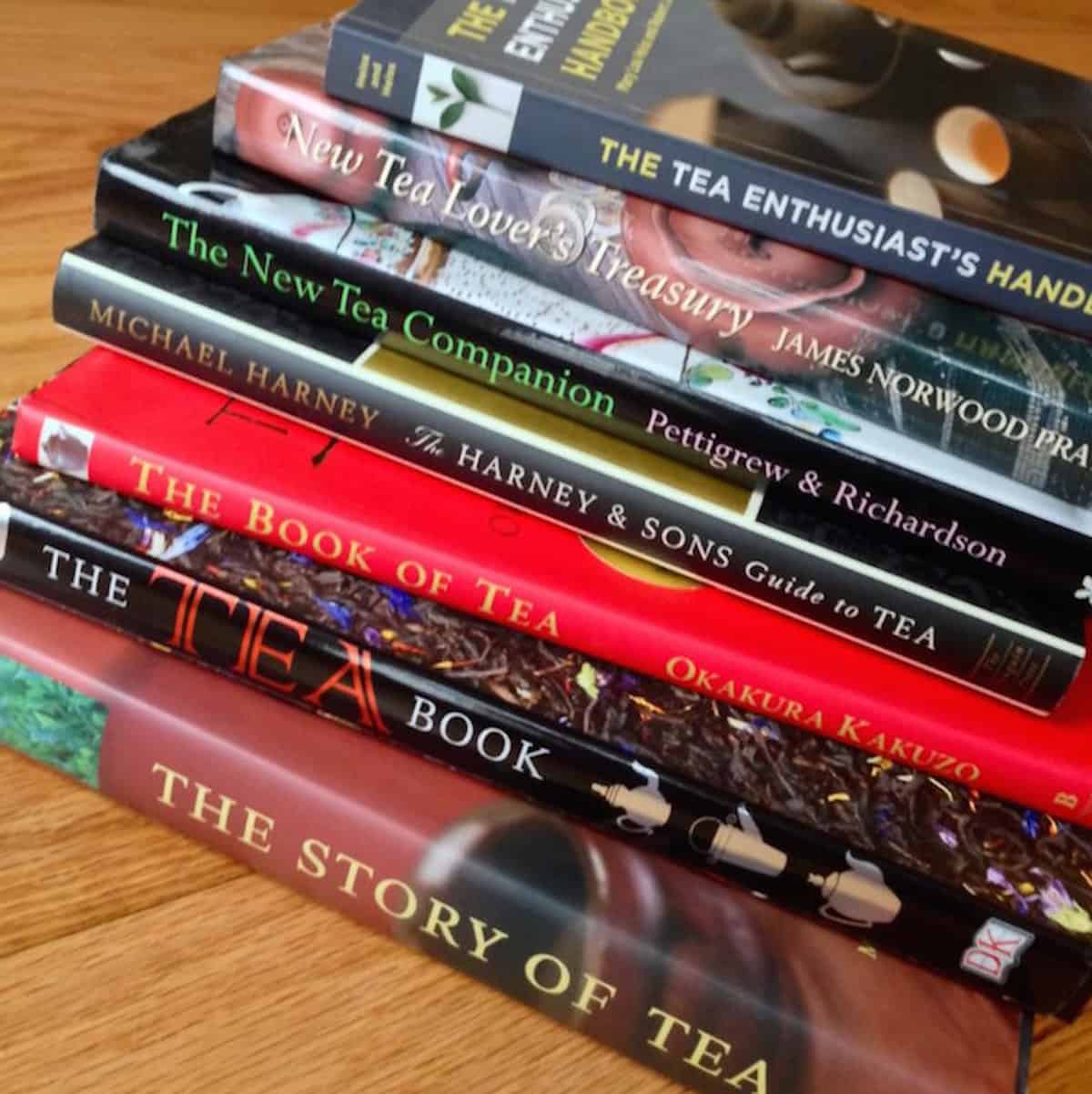
Let's head back to basics today, as in tea basics. I'm writing this review of the ten best tea books that will help make you a tea expert with two goals in mind:
- To share what I've learned about tea.
- To provide access to some of the best tea books in one place. Then we can chat more about TEA!
Today we dive into the world of tea books. Because before our beloved tea became a beverage, it was a leaf. You will know more than most people with some basic knowledge of how tea is made.
Who doesn't yearn for that kind of expertise?!
Whether that is the super nerdy chemistry of tea or simply a favorite tea, these tea books deliver something a little more substantial.
I have ten books in my tea library that I constantly go back to. These are not only my favorites but also the favorites of other tea enthusiasts.

Shades of Earl Grey - $19.95
from: Firebelly Teas Inc.
Best Tea Books
My criteria for selecting these specific books are twofold:
- They have to be timeless favorites.
- They must still be available for purchase.
Any of these books will teach you the "need to know" basics of becoming a tea expert. You will learn about your tea options, where tea comes from, how tea is produced, how to make tea properly, how to taste the tea and appreciate the quality and tea variety.
You can't get a cup of tea big enough or a book long enough to suit me." - C. S. Lewis
Open your mind to learning about and tasting the many available teas. Just realize you can read all you want from a book, but you can't really know tea until you taste it!
This will guide you the next time you walk into a specialty tea shop and stare blankly at all the tea along the wall. In the end, you will find your tea of choice, despite all the variety.
Editor's Pick

The Tea Book by Linda Gaylard
The Tea Book is perfect for beginners and makes a lovely coffee table book.
First, let me say the illustrations are beautiful and abundant. I was impressed with the visuals when I opened the book.
The Tea Book concisely tells the history of tea along with the different forms of tea. Each country is separated and chronicled by the type of tea grown there. Tea traditions worldwide are depicted, including their ceremonies and blends.
The chapter on herbal teas is a nice feature. Most tea books do not cover them in depth since tisanes are not made from the Camellia sinensis plant. An impressive twenty-nine herbs and their benefits are included to blend with traditional teas or consumed independently.
Steeping notes and eighty-eight step-by-step recipes are offered at the end, inviting us to explore all the various ways tea can be enjoyed. I truly enjoy this book.
Best Books On Tea

The Story of Tea by Mary Lou Heiss, Robert J. Heiss
Many people call this the bible of tea books. And it is. The Story of Tea was nominated in 2008 for a prestigious James Beard Book Award and an IACP Cookbook Award. It was awarded Best Tea Book in the USA by Gourmand Awards, Paris, France, and won the Best Tea Book in the World in 2008.
I refer to this book as a textbook on tea. It is not the type of book you read from cover to cover like a novel, although you could. Its 417 pages are more of a reference book for selecting a topic of interest and reading that chapter.
The book begins with a history of tea, and ten chapters later culminate in cooking with tea. The authors take us on a fascinating tour through the world of tea, from China's delicate green tea to the full-bodied Assam black tea of India.
The husband and wife team offers an insider's view of every aspect of the tea trade. Heiss profiles over thirty tea varietals and provides an in-depth guide to tea territories, production, brewing, and tasting.
Many beautiful pictures are peppered throughout the book, including photographs of tea producers and their farms. Chapter five includes a nice encyclopedia of thirty-two different teas.
The latest research on the health benefits of tea is covered while sharing ancient and current knowledge of how tea is beneficial for maintaining health and vigor.
The final chapter includes ten recipes for cooking with tea incorporating tea as a versatile seasoning. I'm seriously thinking about making the green tea chiffon cake with walnuts and crystallized ginger. Dessert first!
A beautifully illustrated and comprehensive book that does not disappoint.
Tea Trekker
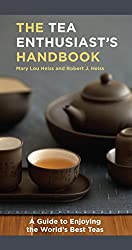
The Tea Enthusiasts Handbook by Mary Lou Heiss, Robert J. Heiss
The Heiss's have two wonderful books on tea. This is a handy little pocket guide in size and scope. It is straightforward and factual. A helpful reference source while exploring the world of tea.
The book covers the six main tea; green, yellow, white, oolong, black, and Pu-erh. Many of the teas discussed are single teas, not blends, and would only be found in high-end tea shops.
Nonetheless, it is a handy book to cover particular tea types, including how to buy, store, and steep tea, along with detailed tasting notes. It might be a little overwhelming if you are very new to tea. I would place this book in the advanced category—an excellent reference for the serious tea taster.
History of Tea
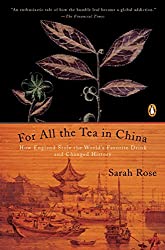
For All The Tea in China by Sarah Rose
If you really want to know about tea, you should know its history and how it came into the western world. This book has become a favorite of mine. It tells the fascinating story of tea espionage as the British East India Company carried it out.
Robert Fortune, the Scottish Botanist, was sent undercover to China on a mission to steal China's closely guarded secrets on tea growing and production.
In 1848, most Chinese territories were forbidden to foreigners. Robert Fortune disguised himself as a Mandarin and traveled deep into the Wu Yi mountains, the center of tea production, to discover their horticultural secrets.
For All the Tea in China is the amazing story of Fortune's journeys deep into China and his tea smuggling adventures. Fortune engaged in the ultimate corporate espionage sealing the fate of empires.
It's well-written historical storytelling.

New Tea Lover's Treasury by James Norwood Pratt
This book reads more like a story, and Pratt makes the history of tea come alive. Of particular interest is the expansion of the British Empire and the monetary motivations behind tea.
Pratt is clearly in love with tea, which shows in this book. He appreciates tea like a wine connoisseur appreciates wine, perhaps because he was one before he switched over to tea. But he understands tea with all of its history and nuanced legends.
A prized book, it's divided into two parts: The Romance of Tea and The Treasury. The Romance of Tea covers tea's history from its inception, while The Treasury goes into some interesting specifics of tea, including tea types and how they came about.
I don't know James Norwood Pratt personally, but I had spoken to him many times about tea when I first started my tea business. He worked very closely with Devan Shah, who sadly passed away. Both were instrumental in helping me select the teas for my tea business.
The New Tea Lover's Treasury is an interesting and informative book written with humor, knowledge, and loving enthusiasm for a simple cup of tea that's not really so simple after all.
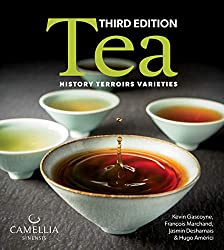
Tea: History, Terroirs, Varieties by Kevin Gascoyne, Francois Marchand, and Jasmin Desharnais
The second edition of this book won Best Tea Book at the World Tea Awards in 2014.
I recently purchased this book and discovered an amazing chapter on tasting tea. If you're looking for a book with a more comprehensive tasting guide, this book has a very nice tasting guide with a flavor wheel included. I've not seen this in any other tea book.
- Cancer Hates Tea: A Book Review
- Tea eBooks
- Foodies Ultimate Guide to Tea Tasting Notes
- 10 Best Online Tea Shops
- World of Tea Book Review
- World of Tea Author Jane Pettigrew Interview
The authors of the book own Camellia Sinensis Tea House in Montreal. They import teas directly from tea producers.
The book details tea, history, and cultivation in great detail—a wonderful tea book. I would categorize it as advanced learning for the tea aficionado.
The Book of Tea
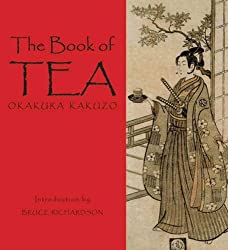
The Book of Tea by Okakura Kakuzo
The Book of Tea is a classic. I love this book. It's more about tea's philosophy, which makes it very special.
The original text of The Book of Tea was first published in 1906. I have the 2011 edition with an introduction by Bruce Richardson, the author of many tea books.
Okakura was a Japanese philosopher who became one of the great thinkers of the 20th century. He is credited with bridging Western and Eastern cultures. He spoke English and Japanese, making him capable of expressing the nuances of tea as practiced by the Japanese.
At the turn of the century, Okakura became the Director of Asian Arts at the Museum of Fine Arts in Boston. Tea became a metaphor for interpreting Japanese art and spirit.
The Book of Tea is an artist's and philosopher's book expressed through tea. Okakura defined tea as the Cup of Humanity, beginning as medicine and growing into a beverage. Tea eventually became an expression of the way of life in the Asian world.
The Book of Tea chronicles how this came about through art, Teaism, Taoism, and Zen. Tea masters elevated tea to an art form, reflecting on life's simplicity through a cup of tea. It's about art, philosophy, spirituality, meditation, design, gardening, architecture, and tea.
It's a very special book.
Tea Sommelier
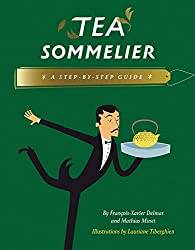
Tea Sommelier by François-Xavier Delmas, Mathias Minet
Tea Sommelier is authored by Palais des Thes owners, another of my favorite tea shops. The Tea Sommelier is a wonderful book, especially if you look for a simple guide to tea and tea pairings with food.
The Tea Sommelier has many colorful illustrations, posters, charts, and step-by-step guides. An effortless and inspiring read. A great reference book if you work in the hospitality industry.
Tea and Books
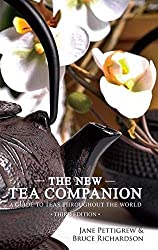
The New Tea Companion by Jane Pettigrew, Bruce Richardson
The New Tea Companion is a brief and comprehensive guide to tea production, the types of tea, and the grading of tea. It includes chapters on the newest information about tea, health, production, blending, and hospitality.
The Tea Directory section is a guide to 80 world teas. Each is beautifully pictured as a dry leaf, a wet leaf, and an infusion describing each character and brewing guide. This directory covers teas from nine major tea-producing countries. The description of every tea-growing region and the specialty of each country is well covered.
Jane Pettigrew is a very bubbly and charming person. I met her once at one of the World Tea Expos. Mostly I love her British accent!
This is a nice reference book for the casual to the serious tea drinker.
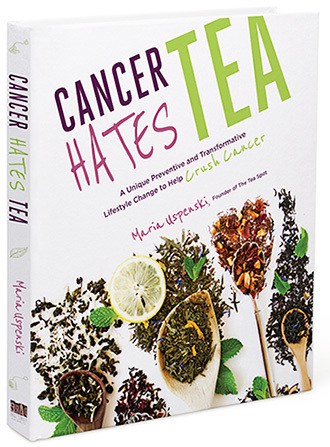
Cancer Hates Tea by Maria Uspenski and Dr. Mary L. Hary
Cancer Hates Tea was a finalist for Best Tea Publication 2017 World Tea Awards. Author Maria Uspenski is the founder of one of my favorite tea shops, The Tea Spot.
Uspenski helps the reader understand the biology of the human body at the cellular level and how cancer affects it. She explains the healing power of tea, backed by 5,000 scientific studies, leaving the reader with a feeling of control over their wellness. The book inspires the reader to overhaul old beverage habits.
Most people don't write about tea solely as it relates to cancer. But it did get my attention. You don't have to have cancer to read this book. It's an amazing tea story with wellness references backed by studies and many wonderful recipes throughout the book.
There are many more tea books out there I don't own. What are your favorite books on tea?
TEA FOR BEGINNERS START HERE >>



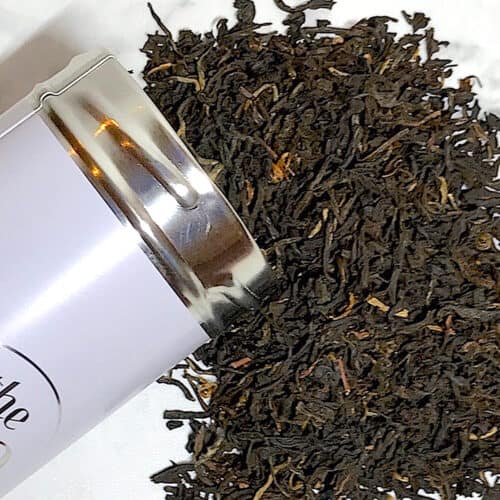
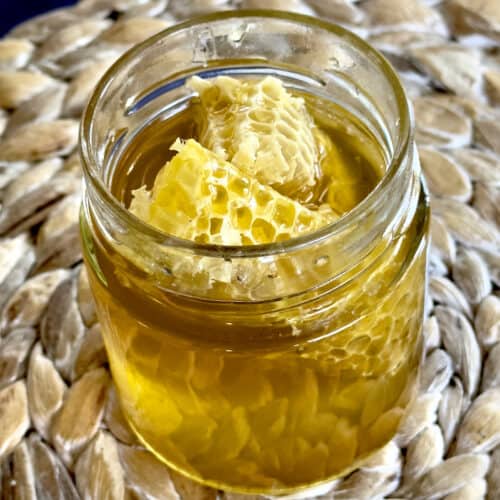
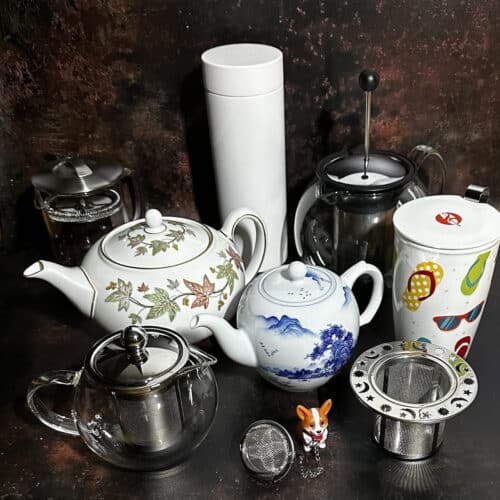
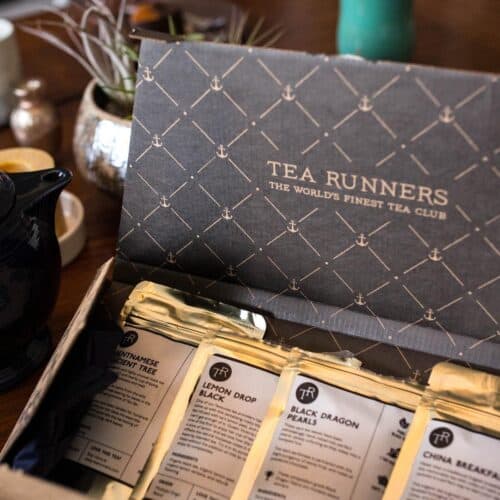
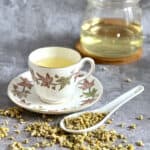
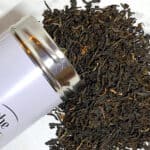
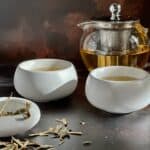
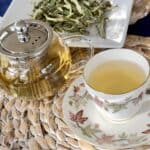


Isabella Whitmore
I began reading this post looking for a good tea book to give to my sister for her birthday. I was captivated by reviews which are interesting and informative and loved all of the books. I found two books my sister will love. I’m interested in tea history and particularly liked New Tea Lover’s Treasury.
Thank you very much Mary Ann for taking time to write the post.
Ben
Thanks for the great post. I'm planning on buying my wife a whole bunch of tea stuff this Christmas, including some books for educating herself, and your article helped a lot. Thank you very much!
Mary Ann Rollano
Thank you so much. You are so welcome! Glad you liked it!
Ruth
I truly enjoyed reading this article. Thank you for taking the time to share great knowledge.
What is your advice for a Herbal/Tea enthusiast that wants to become an entrepreneurial in the business of Tea? How do you get started?
Mary Ann Rollano
The best advise I can give you is to learn a much as you can about tea and the business of tea as you can. You don't necessarily need to be an expert but if you're not you should surround yourself with experts in tea and in business. You can do this through classes and tea associations. The World Tea Expo is held every year in June and is an industry trade show focusing on the business of tea. You may find it very helpful. The Tea and Herbal Association of Canada may also be a good resource as they focus on tea and herbals. Both associations have many resources on and offline.
ricky edmunds
I hope to get all 7 books
Mary Ann Rollano
And you should. They make a wonderful tea library!
Islay
Thank you for these recommendations, I have some of these books already but I am looking for an audiobook as I am going to Sri Lanka and India on a tea tour and am looking for a good read to listen to rather than suffer travel sickness reading. I'd be delighted if you could recommend something?
Mary Ann Rollano
You might find the book For All the Tea in China: How England Stole the World's Favorite Drink and Changed History
by Sarah Rose interesting. It's available as an audiobook and provides a great history of how England's botanist Robert Fortune was sent to China to steal the tea crops from deep within China and bring them back for British plantations in India. It's a fascinating read - or listen!
Do tell us about your tea tour when you return!
Suren Ambegaokar
Thanks for this post and for your very helpful, informative, and concise reviews. I am developing a college course for incoming freshman to demonstrate the multiple facets through which a topic can be explored, and I realized that TEA is a perfect topic to explore (horticulturally, chemically, culturally, historically, politically, biologically/medicinally, etc.). These reviews are very helpful to help me get a start on some background knowledge and pick a few books to start on. From your reviews I have some good ideas of where to start looking, but is there one book that would recommend that would engage 17-19 year olds that was about 100-300 pages long, that discussed tea from several of the perspectives I mentioned above? Thanks!
Mary Ann Rollano
That sounds like a wonderful course. I would recommend The Tea Book by Linda Gaylord as a perfect intro book. It covers most of the areas you would like to teach and it is very visual with lots of photos. The book is very engaging and a good introduction to all varieties of tea and tea culture. It will hold a 19 year olds interest. What college?
Donald Maxton
I enjoyed your reviews. Please contact me if you would like to see my list of nearly 200 books about tea and tea-related ephemera. Thank you.
Mary Ann Rollano
200 books? Sounds like an impressive list.
michael Harney
Thanks Hilary,
I ws just at my publisher's office at Penguin. We have found a way to keep this book in print.
By the way, Norwood turns 75 this year.
Mary Ann Rollano
It's a great book Michael. (So is Norwood Pratt's book). Glad you're going to keep it in print!
3r Global
I want those books while drinking my tea.
Hilary Lazell
Thank you so much for these reviews - really useful. I have been contemplating several of these; now I know which to purchase first.
Mary Ann
Hilary,
I'm glad you found the reviews helpful. Thanks for reading!
Mary Ann